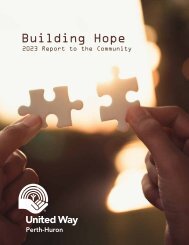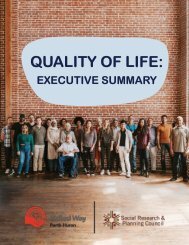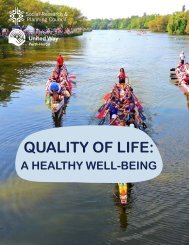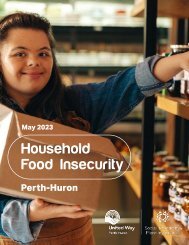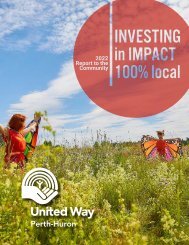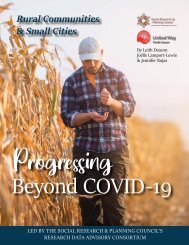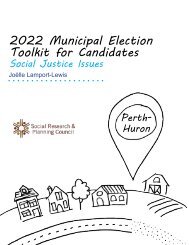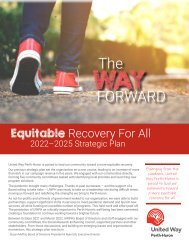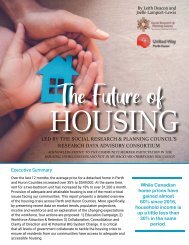2023 11 17 WHO WE ARE
Create successful ePaper yourself
Turn your PDF publications into a flip-book with our unique Google optimized e-Paper software.
Operated by:<br />
QUALITY OF LIFE:<br />
<strong>WHO</strong> <strong>WE</strong> <strong>ARE</strong>
][<br />
Quality of Life Subcommittee<br />
Dariel Bateman<br />
Beth Blowes<br />
Jeneane Fast<br />
Kehlar Hillyer<br />
Leah Kennedy<br />
Joelle Lamport-Lewis<br />
Barb Leavitt<br />
Robin Spence Haffner<br />
Jennifer Rojas<br />
Nancy Summers<br />
Kathy Vassilakos<br />
Special thanks given to advisors<br />
from Huron Perth Public Health:<br />
Erica Clark, PhD<br />
Angela Willert<br />
The Social Research & Planning Council is funded by:<br />
City of Stratford, Town of St. Marys,<br />
County of Perth, through the Department of Social Services,<br />
the County of Huron, and United Way Perth-Huron.<br />
Thank you to all the community partners who<br />
contributed to this project. We value your contribution.<br />
Social Research & Planning Council<br />
United Centre, 32 Erie St., Stratford, ON N5A 2M4<br />
Tel: 519-271-7730<br />
Email: srpc@perthhuron.unitedway.ca<br />
www.perthhuron.unitedway.ca/social-research-planning-council
Who We Are<br />
In this section, you will find demographic statistics from the<br />
most recent Census of Canada (2021) and a few estimators from<br />
Environics Analytics. Understanding the demographics of a<br />
community is like having a roadmap to meet unique needs. Who<br />
We Are provides crucial information about the people who make<br />
up the Perth-Huron region. Knowledge and understanding of<br />
details such as age, gender, family composition and geography<br />
help tailor programs and services that resonate with the<br />
community’s specific needs.<br />
Page 3 Demographics
Perth & Huron Counties<br />
The counties of Perth and Huron are located in southwestern<br />
Ontario. Huron County borders the southeast shore of Lake<br />
Huron and Perth County is located to the east of Huron. Together<br />
with Bruce and Grey Counties, they make up the Stratford-Bruce<br />
Peninsula Economic Region. Perth County is on the traditional<br />
territory of the Mississauga, Anishinaabe, Haudenosaunee<br />
(Iroquois) and Attiwandaronk (Neutral) peoples. Huron County<br />
is on the traditional territory of the Haudenosaunee (Iroquois),<br />
Ojibway/Chippewa, Attiwandaronk (Neutral) and Anishinaabe<br />
peoples. The territory of Perth and Huron is covered by the Huron<br />
Tract registered as Treaty 29 in the Upper Canada Treaties of 1827<br />
and by the Saugeen Tract registered as Treaty 45 ½ in 1836.<br />
Identified as a rural area, Perth-Huron is a rich agricultural region<br />
with more than 4,850 farms and around 8<strong>11</strong>,637 farm area-acres;<br />
two-thirds of which are in Huron County. 1<br />
As significant population centres, the City of Stratford and the<br />
Town of St. Marys are within the Perth County census division.<br />
However, they have their own single-tier municipal governments.<br />
Goderich is identified as Huron County’s largest community.<br />
Land Area & Dwellings Characteristics Perth Huron Stratford<br />
Total private dwellings* 34,062 29,455 15,388<br />
Population density per square kilometre 36.8 18.1 1,107.0<br />
Land area in square kilometeres 2,218 3,398 30.02<br />
Private dwellings occupied by usual residents** 32,772 25,334 14,743<br />
Table 1<br />
Source: Statistics Canada, Census 2021. Population and dwellings section.<br />
* Private dwelling refers to a separate set of living places with a private entrance either from<br />
outside the building or from a common hall, lobby, vestibule or stairway inside the building.<br />
** A private dwelling occupied by usual residents refers to a private dwelling in which a<br />
person or a group of persons is permanently residing.<br />
Page 4 Who We Are
Diagram 1: Borders of Southwestern Ontario<br />
Source: 2 3 4<br />
Map features are an approximate representation and are not intended to provide a high level of<br />
accuracy
Population Size and Growth<br />
According to the last three censuses, Canada is maintaining a<br />
consistent rate of growth. Overall, the population changed by 5.2%.<br />
However, Ontario has a more rapid increase of 5.8%. 5<br />
Canada<br />
Census Population Population<br />
Change<br />
Census<br />
Ontario<br />
Population Population<br />
Change<br />
20<strong>11</strong> 33,476,688 20<strong>11</strong> 12,851,821<br />
5%<br />
4.60%<br />
2016 35,151,728 2016 13,448,495<br />
5.20%<br />
5.80%<br />
2021 36,991,981 2021 14,223,942<br />
Table 2: Population Change, Canada-Ontario<br />
Source: Statistics Canada, Census 20<strong>11</strong>, 2016 and 2021. Population and dwellings section.<br />
Perth Expected to Have a Greater Population<br />
Increase Than Huron by 2032<br />
According to the most recent census (2021), 81,565 and 61,366<br />
people live in Perth and Huron respectively. The population has<br />
increased by 6,822 new people and Huron had a smaller increase<br />
than Perth. Some municipalities have declined in population over<br />
the last few years. Based on some estimates, the total population<br />
in Perth-Huron will change by <strong>11</strong>% in 2032. 6<br />
Perth-Huron<br />
population<br />
increased by<br />
6,822<br />
in five years<br />
Graph 1: Total Population, 20<strong>11</strong>–2021, Perth-Huron<br />
Source: Statistics Canada, Census 20<strong>11</strong>, 2016 and 2021. Population and dwellings section.<br />
100,000<br />
90,000<br />
80,000<br />
75,<strong>11</strong>2 76,812<br />
81,565<br />
88,141<br />
85,992<br />
93,450<br />
70,000<br />
60,000<br />
59,100 59,297<br />
61,366<br />
63,681 64,6<strong>11</strong><br />
66,822<br />
50,000<br />
40,000<br />
30,000<br />
20,000<br />
10,000<br />
0<br />
20<strong>11</strong> 2016 2021 2025 2027 2032<br />
Page 4 Who We Are<br />
Perth Huron
Central Population 2016 2021 % Change<br />
PERTH 76,812 81,565 6.20%<br />
North Perth 13,130 15,538 18.30%<br />
Perth East 12,277 12,595 2.60%<br />
Perth South 3,805 3,776 -0.80%<br />
St. Marys 7,265 7,386 1.70%<br />
Stratford 31,470 33,232 5.60%<br />
West Perth 8,865 9,038 2.00%<br />
HURON 59,297 61,366 3.50%<br />
Ashfield-Colborne-Wawanosh 5,422 5,884 8.50%<br />
South Huron 10,096 10,063 -0.30%<br />
North Huron 4,932 5,052 2.40%<br />
Morris-Turnberry 3,496 3,590 2.70%<br />
Huron East 9,138 9,512 4.10%<br />
Howick 3,873 4,045 4.40%<br />
Goderich 7,628 7,881 3.30%<br />
Central Huron 7,576 7,799 2.90%<br />
Bluewater 7,136 7,540 5.70%<br />
Table 3: Population Growth by Central Populations, 2016–2021<br />
Source: Statistics Canada, Census 2016 and 2021. Census subdivision. Population and<br />
dwellings section.
The Median Age in Perth and Huron<br />
is Higher Than the Province<br />
The current median age is 42.4 in Perth and 46.8 in Huron; both<br />
higher than the provincial median of 41.6. The median age in the area<br />
hasn’t changed over the last five years. The distribution of population<br />
across broad age categories has not changed significantly. The<br />
proportion of the population aged 65 and older is projected to<br />
increase by 2032. Individuals aged 60–64 are the largest percentage<br />
of the population. 7<br />
Diagram 2: Age of Population, Perth-Huron 2021<br />
Source: Statistics Canada, Census 2021. Age characteristics.<br />
<strong>17</strong> % 59%<br />
2 1%<br />
3%<br />
0-14 Years<br />
15-64 years 65 to 84 years<br />
85 years+
Graph 2: Population by Age and Gender* distribution, Perth-Huron, 2021<br />
Source: Statistics Canada, Census 2021. Age characteristics.<br />
100 years and over<br />
95 to 99 years<br />
90 to 94 years<br />
85 to 89 years<br />
80 to 84 years<br />
75 to 79 years<br />
70 to 74 years<br />
65 to 69 years<br />
60 to 64 years<br />
Age group<br />
55 to 59 years<br />
50 to 54 years<br />
45 to 49 years<br />
40 to 44 years<br />
35 to 39 years<br />
30 to 34 years<br />
25 to 29 years<br />
20 to 24 years<br />
15 to 19 years<br />
10 to 14 years<br />
5 to 9 years<br />
0 to 4 years<br />
-10.0% -8.0% -6.0% -4.0% -2.0% 0.0% 2.0% 4.0% 6.0% 8.0% 10.0%<br />
Population<br />
Women+<br />
Men+<br />
*Gender refers to an individual’s personal and social identity as a<br />
man, woman or non‐binary person (a person who is not exclusively<br />
a man or a woman). Some people may not identify with a specific<br />
gender. Beginning in 2021, the variable “gender” is expected to<br />
be used by default in most social statistics. However, the “+”<br />
sign covers other identities that may not be disaggregate due to<br />
the sampling. Men+ includes men, boys and some non-binary<br />
persons. Women+ includes women, girls and some non-binary<br />
persons. (Statistics Canada: Dictionary, Census Population, 2021)<br />
Page 9 Who We Are
Birth Rate Has Remained Relatively Stable<br />
The birth rate in Perth–Huron has remained stable since 20<strong>11</strong> and<br />
higher than the provincial average since 2018. The average age<br />
at which a mother has her first infant is 27 years, lower than the<br />
provincial average (29.3). 41,870 children were recorded in the last<br />
census, 12% of whom live in a one-parent family. 8<br />
Families and Households<br />
The following pages describe the main features of family composition in<br />
Perth and Huron Counties based on Census 2021 findings.<br />
Page 10 Who We Are
PERTH<br />
Diagram 3: PERTH, Household Feature 9<br />
#<br />
Total private<br />
32,770 households<br />
Private Households<br />
28% 1 person<br />
12%<br />
4 persons<br />
38% 2 persons<br />
9%<br />
5 or more<br />
persons<br />
13%<br />
3 persons<br />
2<br />
Average number of<br />
children in private<br />
household<br />
Married Couple Common-law couple One-parent families<br />
with children<br />
48%<br />
with children<br />
39%<br />
parent is<br />
man+<br />
23%<br />
without<br />
52%<br />
without<br />
61%<br />
parent is<br />
woman+<br />
77%
Diagram 4: HURON, Household Feature 10<br />
#<br />
25,335<br />
Total private<br />
households<br />
Private Households<br />
29% 1 person<br />
40% 2 persons<br />
<strong>11</strong>%<br />
9%<br />
4 persons<br />
5 or more<br />
persons<br />
12%<br />
3 persons<br />
2<br />
Average number of<br />
children in private<br />
household<br />
Married Couple Common-law couple One-parent families<br />
with children<br />
43%<br />
with children<br />
37%<br />
parent is<br />
man+<br />
26%<br />
without<br />
57%<br />
without<br />
63%<br />
parent is<br />
woman+<br />
74%<br />
Page 12 Who We Are<br />
HURON
Ontarians Relocating is Main Contributor<br />
to Population Growth<br />
The main factor contributing to population growth in the Stratford-Bruce<br />
Peninsula is the net intraprovincial migration of individuals moving from<br />
elsewhere in Ontario, with rates increasing significantly over the last five<br />
years. In the last year’s period (2020 to 2021) the net interprovincial<br />
loss (individuals moving out of province) of 469 people was the<br />
most significant loss over the last five years. The number of net nonpermanent<br />
residents (also referred to as temporary residents) decreased<br />
drastically in 2019-2020 as a result of the COVID-19 pandemic and<br />
restrictions, rebounding in 2020-2021. Overall migration numbers have<br />
remained comparable from 2016 to 2021. <strong>11</strong><br />
Graph 3: Population Mobility<br />
Source: Statistics Canada, Annual Demographic Estimates: Sub-provincial Areas. Population estimates and growth.<br />
2020-2021<br />
-469<br />
296<br />
366<br />
4146<br />
2019-2020<br />
-94<br />
91<br />
304<br />
4,033<br />
2018-2019<br />
-<strong>17</strong><br />
196<br />
370<br />
3,504<br />
620<br />
296<br />
3,594<br />
2020-2021 -469<br />
87<br />
4146<br />
366 370<br />
91<br />
2019-2020<br />
295<br />
-94<br />
4,033<br />
-95 304<br />
3,319<br />
196 320<br />
2018-2019 -<strong>17</strong><br />
3,504<br />
370 422<br />
1,575<br />
-134 620<br />
20<strong>17</strong>-2018<br />
87<br />
3,594<br />
370<br />
325<br />
-18 295<br />
2016-20<strong>17</strong> -95<br />
769<br />
3,319<br />
-483 320<br />
232<br />
422<br />
2015-2016 -134<br />
1,575<br />
-39 325<br />
356<br />
-470 -18<br />
2014-2015 -483<br />
237769<br />
232<br />
-39<br />
55<br />
2013-2014 -470<br />
356 733<br />
-442 237 252<br />
55<br />
2012-2013 -442<br />
733<br />
-15<br />
-308 252<br />
-351<br />
218<br />
-351<br />
-308<br />
-15<br />
20<strong>11</strong>-2012<br />
218<br />
-1000 0 1000 2000 3000 4000 5000<br />
-1000 0 1000 2000 3000 4000 5000<br />
20<strong>17</strong>-2018<br />
2016-20<strong>17</strong><br />
2015-2016<br />
2014-2015<br />
2013-2014<br />
2012-2013<br />
20<strong>11</strong>-2012<br />
Net non-permanent residents<br />
Net intraprovincial migration<br />
Net interprovincial migration Inmigrants<br />
Net non-permanent residents Net intraprovincial migration Net interprovincial migration Immigrants
More Than 90% of the Population Has Remained<br />
in the Same Residence<br />
Less than 10% of the population has changed their place of<br />
residence (“mover”) over the last year. Of those who did, most<br />
moved intraprovincially (from elsewhere within Ontario). The<br />
proportion of intraprovincial migrants in Perth and Huron Counties<br />
is higher than the provincial average. The proportion of external<br />
migrants (those who come from outside Canada) is very low<br />
in Perth-Huron, as is the proportion of interprovincial migrants<br />
(people who have moved from other provinces). Five years ago, the<br />
proportion of people who moved residences was higher across all<br />
categories. 12<br />
Net interprovincial represents the difference<br />
between in-migrants and out-migrants for a<br />
given province or territory involving a change in<br />
the usual place of residence.<br />
Net intraprovincial represents the difference<br />
between in-migrants and out-migrants in a given<br />
region. A region can be defined as an economic<br />
region.<br />
Non-mover refers to a person who lived in the<br />
same residence one and five years earlier<br />
Non-migrants refers to people who move within<br />
their same census subdivision. 8<br />
Non-permanent residents are persons<br />
lawfully in Canada on a temporary basis<br />
under the authority of a temporary<br />
resident permit, along with members of<br />
their family living with them. This includes<br />
foreign workers, foreign students, the<br />
humanitarian population and other<br />
temporary residents. The humanitarian<br />
population includes refugee claimants and<br />
temporary residents allowed to remain in<br />
Canada on humanitarian grounds and are<br />
not categorized as either foreign workers or<br />
foreign students.<br />
Immigration in Perth-Huron is<br />
Lower Than the Province<br />
The 2021 Census of Canada reported that 9.1% of the total<br />
population are immigrants in Perth and 6.9% in Huron. These rates<br />
are lower than the provincial rate of 29.97%. Representation by<br />
gender is similar in both counties. 13<br />
The percentage<br />
of immigrants in<br />
Perth-Huron is<br />
significanly lower<br />
than the Ontario<br />
average<br />
Page 14 Who We Are
Graph 4: Immigrant arrival as a percentage of total population,<br />
Perth, Huron & Ontario, 20<strong>11</strong> to 20<strong>17</strong><br />
Source: Rural Ontario Institute, Trend in annual immigrant arrivals to census divisions in Ontario, 1997 to 20<strong>17</strong>.<br />
0.9<br />
0.8<br />
0.7<br />
0.76 0.77<br />
0.75<br />
0.65<br />
0.8<br />
0.7<br />
0.6<br />
0.5<br />
0.4<br />
0.3<br />
0.2<br />
0.1<br />
0<br />
0.22 0.21<br />
0.22<br />
0.<strong>17</strong><br />
0.07<br />
0.13<br />
0.<strong>11</strong><br />
0.02<br />
0.04 0.03<br />
0.08 0.07<br />
20<strong>11</strong>-2012 2012-2013 2013-2014 2014-2015 2015-2016 2016-20<strong>17</strong><br />
Huron Perth Ontario<br />
6.9% of<br />
Huron population<br />
are immigrants<br />
9.1% of Perth<br />
population are<br />
immigrants<br />
The highest level of immigrant arrival documented in Perth<br />
was in 20<strong>11</strong>-2012 and 2015-2016. Huron shows a lower<br />
percentage of immigrant arrival in general and its most<br />
significant increase was in 2015-2016 when immigration<br />
numbers in Canada spiked as a response to the war in Syria<br />
and the Government of Canada’s response. According to<br />
Immigration, Refugees and Citizenship Canada (IRCC) data,<br />
over 25,000 Syrian refugees landed in Canada between<br />
December 1, 2015 and the end of February, 2016.
Graph 5: Immigrants by place of birth, Perth & Huron, 2021 Census, Canada<br />
Source: Statistics Canada, Census of Population, 2021.<br />
57% Europe<br />
<strong>17</strong>% Asia<br />
22%<br />
America<br />
3%<br />
1%<br />
Africa<br />
Oceania
References<br />
1 Ontario Ministry of Agriculture, Food and Rural Affairs Statistics. County Profile: Agriculture.<br />
Food and Business. Western Ontario. Data from Agriculture Census Canada 2021. Retrieved from<br />
https:// data.ontario.ca/dataset/ontario-farm-data-by-county<br />
2 Burrell, M. (n.d.) Ontario County Map. Retrieved from https://www.google.com/<br />
maps/d/u/0/embed?mid=1kKPz6L-BMydiGF0UHmJYfjgBuoY&ll=43.97243203622612%2C-<br />
81.86231472408687&z=8<br />
3 Map of Ontario treaties and reserves. Retrieved from https://www.ontario.ca/page/mapontario-treaties-and-reserves<br />
4 Native Land Map. Retrieved from https://native-land.ca/<br />
5 Statistics Canada. 2022. (table). Census Profile. 2021 Census of Population. Statistics Canada<br />
Catalogue no. 98-316-X2021001. Ottawa. Released October 26, 2022. Retrieved from www12.statcan.<br />
gc.ca/census-recensement/2021/dp-pd/prof/index.cfm?Lang=E<br />
6 Statistics Canada. 2022. (table). Census Profile. 2021 Census of Population. Statistics Canada<br />
Catalogue no. 98-316-X2021001. Ottawa. Released October 26, 2022. Retrieved from www12.statcan.<br />
gc.ca/census-recensement/2021/dp-pd/prof/index.cfm?Lang=E<br />
7 Statistics Canada. 2022. (table). Census Profile. 2021 Census of Population. Statistics Canada<br />
Catalogue no. 98-316-X2021001. Ottawa. Released October 26, 2022. Retrieved from www12.statcan.<br />
gc.ca/census-recensement/2021/dp-pd/prof/index.cfm?Lang=E<br />
8 Statistics Canada. 2022. (table). Census Profile. 2021 Census of Population. Statistics Canada<br />
Catalogue no. 98-316-X2021001. Ottawa. Released October 26, 2022. Retrieved from www12.statcan.<br />
gc.ca/census-recensement/2021/dp-pd/prof/index.cfm?Lang=E<br />
9 Statistics Canada. 2022. (table). Census Profile. 2021 Census of Population. Statistics Canada<br />
Catalogue no. 98-316-X2021001. Ottawa. Released October 26, 2022. Retrieved from www12.statcan.<br />
gc.ca/census-recensement/2021/dp-pd/prof/index.cfm?Lang=E<br />
10 Statistics Canada. 2022. (table). Census Profile. 2021 Census of Population. Statistics Canada<br />
Catalogue no. 98-316-X2021001. Ottawa. Released October 26, 2022. Retrieved from www12.statcan.<br />
gc.ca/census-recensement/2021/dp-pd/prof/index.cfm?Lang=E<br />
<strong>11</strong> Statistics Canada. 2022. (table). Census Profile. 2021 Census of Population. Statistics Canada<br />
Catalogue no. 98-316-X2021001. Ottawa. Released October 26, 2022. Retrieved from www12.statcan.<br />
gc.ca/census-recensement/2021/dp-pd/prof/index.cfm?Lang=E<br />
12 Statistics Canada. 2022. (table). Census Profile. 2021 Census of Population. Statistics Canada<br />
Catalogue no. 98-316-X2021001. Ottawa. Released October 26, 2022. Retrieved from www12.statcan.<br />
gc.ca/census-recensement/2021/dp-pd/prof/index.cfm?Lang=E<br />
13 Statistics Canada. 2021. Dictionary, Census of population. Census year 2021. Released<br />
November 7, 2021. Retrieved from https://www12.statcan.gc.ca/census-recensement/2021/ref/dict/<br />
az/index-eng.cfm<br />
About the SRPC<br />
The Social Research & Planning Council (SRPC), operated by United Way Perth-<br />
Huron, is comprised of community representatives who are dedicated to the collection,<br />
analysis and distribution of information relating to social trends and issues in Perth and<br />
Huron Counties. The SRPC approaches its work in two ways:<br />
1. Commissioning research into specific social issues.<br />
2. Developing recommendations for community improvement based on local findings<br />
and working collaboratively with community members to implement change.
WRITING<br />
Areeba Ahmad<br />
Kristin Crane<br />
Will Wellington<br />
EDITING<br />
Chad Alberico<br />
DESIGN<br />
Sonya Heyen<br />
Copyright © The Social Research & Planning<br />
Council <strong>2023</strong>. This work is copyrighted. It<br />
may be reproduced in whole or in part for<br />
educational use subject to the inclusion of an<br />
acknowledgement of the source.<br />
Icons made by SlidesToGo.



